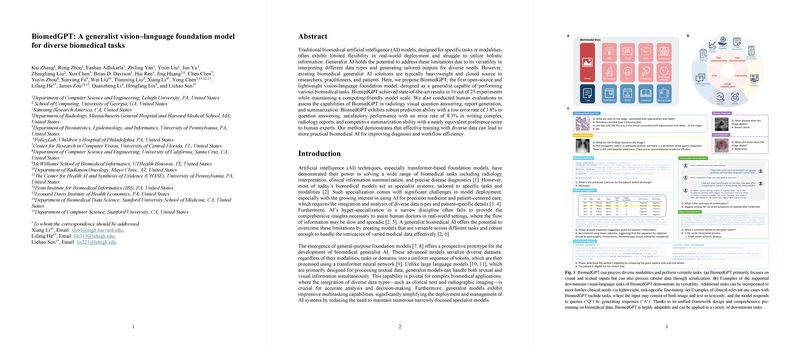Overview of "BiomedGPT: A Unified Biomedical Generative Pre-trained Transformer for Vision, Language, and Multimodal Tasks"
The paper "BiomedGPT: A Unified Biomedical Generative Pre-trained Transformer for Vision, Language, and Multimodal Tasks" introduces a novel open-source model tailored for the diverse requirements of biomedical data processing and interpretation. BiomedGPT aims to bridge the gap between specialized AI models traditionally designed for specific tasks or modalities and the need for adaptable, generalist AI solutions in healthcare. By leveraging advances in transformer architectures, the authors propose a unified model that addresses the inherent complexities of processing multiple data types prevalent in the biomedical domain.
The research highlights several strong numerical outcomes through rigorous experimentation. BiomedGPT achieved state-of-the-art (SOTA) performances across 16 metrics spanning five clinically significant tasks on 26 datasets. For instance, the model surpassed results from both OpenAI's GPT-4V in radiology human evaluation and Google's Med-PaLM M (12B) models in tasks related to breast cancer diagnosis and medical visual question answering. These results underscore BiomedGPT's robust capability in handling multimodal tasks, a critical advantage in a field as interdisciplinary as biomedicine.
Model Architecture and Pre-training
The foundation of BiomedGPT lies in its architectural design drawing inspiration from BART, a well-regarded seq2seq model, yet incorporating modifications such as multiple normalization layers and distinct relative position biases to optimize it for diverse biomedical data. The model employs a unified tokenization approach to harmonize input and output processing across different modalities, leveraging a vocabulary drawn from text, location, and image tokens. This design eliminates task-specific modules, making BiomedGPT a versatile tool.
Pre-training focused on self-supervised learning across 14 publicly-available biomedical datasets, covering a wide range of modalities including images, texts, and image-text pairs. These datasets collectively encompassed over 352,000 images and 183 million text sentences. The model was simultaneously trained on five foundational tasks: image modeling, LLMing, image captioning, visual question answering, and object detection, thereby equipping it with extensive pre-trained knowledge suitable for downstream adaptation.
Fine-tuning and Evaluation
BiomedGPT was rigorously fine-tuned and tested across multiple downstream tasks specifically relevant to biomedical applications. Key tasks included medical image classification, text summarization, and multimodal tasks like image captioning and VQA. The model exhibited outstanding adaptability, as evidenced by achieving first-place rankings in 15 out of 25 controlled experiments. Notably, BiomedGPT's lightweight architecture of 182 million parameters significantly underscored its efficiency, punching above its weight against larger models in tasks such as VQA and image classification.
During evaluation, metrics such as accuracy for classification tasks, ROUGE-L for text summarization, and CIDEr for image captioning provided quantifiable benchmarks wherein BiomedGPT excelled. The human evaluation further validated its practical applicability in clinical settings, particularly in radiology, where it outperformed GPT-4V in providing contextually accurate answers.
Implications and Future Directions
BiomedGPT's developmental endeavor marks a considerable step towards unifying AI models in the biomedical sector. By open-sourcing both the model and its training process, the authors promote transparency and community collaboration, fostering further innovation and refinement. However, the paper acknowledges ongoing challenges such as the imbalance in available biomedical data and the need for improved evaluation metrics that address the nuanced factuality requirements of AI-generated content.
Future research directions may explore scaling BiomedGPT to incorporate even broader datasets and diverse modalities, including structured clinical data and genomic sequences. Addressing negative transfer issues, perhaps through advanced parameter-efficient fine-tuning techniques, is another promising avenue. Such endeavors could further align BiomedGPT with the intricate demands of patient-centered care, ultimately augmenting its utility across healthcare initiatives.
In conclusion, BiomedGPT exemplifies a significant stride towards developing versatile, generalist AI solutions capable of revolutionizing various sectors within healthcare. Its open-source nature and demonstrated competencies highlight potential pathways for enhanced integration and utilization in clinical settings, paving the way for improved patient outcomes through AI-empowered insights.
